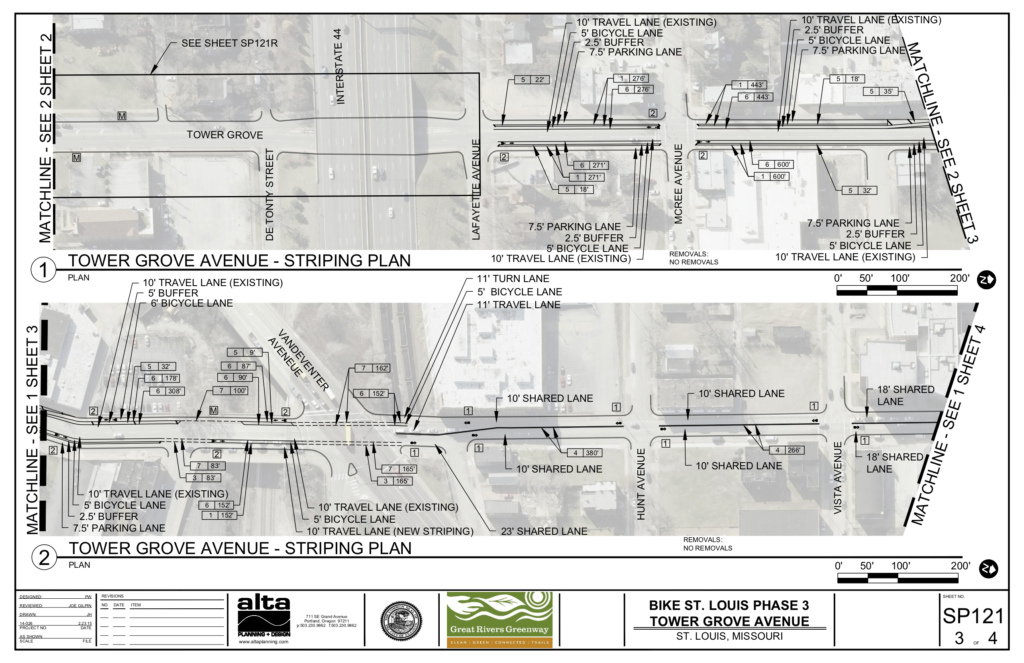This past May a stretch of Tower Grove Avenue bike lanes approaching a difficult intersection was removed. The result has been confusion and decreased safety for cyclist and drivers alike on one of St. Louis’ busiest bike routes. Why did the City remove well-established and appreciated bike infrastructure with no input from the community? Here’s what we learned.

Left panel. Bike lanes (technically, “bike slots”) on Tower Grove Avenue at Vandeventer Avenue were installed in Summer 2013. Right panel. They were removed in May 2018.
A Brief History
Tower Grove Avenue has long been an important bicycle corridor between the Central West End and Tower Grove Park neighborhoods. It was recognized as a key route at least as far back as 2002, and in 2013 it was prioritized as part of Bike St. Louis Phase 3, a $1.4M effort to expand and upgrade a total of 135 miles of street routes for bicycles. Significant engineering effort was focused on the critical Tower Grove Avenue and Vandeventer intersection, and in August 2013 St. Louis City installed a “bike slot” on southbound Tower Grove Avenue there. This design was very helpful at guiding cyclists across the complex intersection and was overwhelming appreciated by the people who bike there. Recognizing its importance the City repainted it regularly.

Design drawings for Bike St. Louis Phase 3 lane markings on Tower Grove Avenue at Vandeventer. A lot of engineering went into making this intersection as safe as possible for cyclists.
Today, Tower Grove Avenue continues to be identified as a key connection for biking: it is included in Trailnet’s Connect STL plan and a vision for its future was recently featured in Across STL magazine (see p. 10).
Why were the bike lanes removed?
The removal of the bike lanes on Tower Grove Avenue at Vandeventer happened unexpectedly in May 2018. It quickly raised concern among cyclists who use that route and was featured in a story by local TV station KMOV. We talked to cyclists, advocates, engineers, and the St. Louis Traffic Commissioner about what happened and why.
There has been no left turn from southbound Tower Grove Ave at Vandeventer since at least 2013. We’ve learned that when the Streets department acquired new facilities on Central Industrial Drive, they decided to install a left turn lane to better accommodate truck traffic. The intersection is narrow and complex, and apparently does not have enough room for both car and bike lanes. So the bike lane was removed and the car lanes widened to allow for better flow of truck traffic.

Left panels. Lane configuration before (left) and after removal of the “bike slot” on southbound Tower Grove Avenue at Vandeventer Avenue. The left lane changed from straight-only to left-only, while the right lane changed from right-only to straight and right, with a sharrow added for bicycle guidance. Right panel. Intersection of Tower Grove Ave and Vandeventer, with Central Industrial Drive going east. Left turn lane on southbound Tower Grove Ave was added to ease truck traffic into Central Industrial.
We spoke to St. Louis Traffic Commissioner Deanna Venker about this change, and she indicated that this was an internal decision within her office. There was no input from Aldermen or consultation with the community when removing the bike lanes. “Making these changes is part of my job description,” she said.
The intersection is now significantly more dangerous and confusing for drivers and cyclists. Whereas cyclists used to have a clearly marked lane to wait out the light without impeding traffic, now one bicycle will block all straight-thru and right-turning cars. Impatient drivers have been seen to illegally use the left lane to bypass waiting cars and turn right, and once in the intersection cars don’t know whether to pass cyclists on the left or right (both happen). There seems to be general confusion by drivers (even bus drivers!) about which lane to use when going straight, a bad situation for cyclists when riding a complicated five-way intersection.
In a nutshell, given conflicting demands between the safety of cyclists and convenience of truck drivers on a key bicycle route, the St. Louis Streets Department sided with the trucks.
Looking ahead
There are a number of ways this situation could be improved for cyclists. At the engineering level, urban design guides spell out ways to accommodate both cyclists and drivers at complicated intersections. Commissioner Venker indicated that she is open to considering innovative solutions such as bike boxes – we certainly hope she does, while engaging the cycling and pedestrian communities in the process.
The issue of bike-friendly street design is bigger than just one intersection or any particular traffic commissioner, however, and needs systemic solutions. In 2015 St. Louis City hired a Bicycle Pedestrian Coordinator whose aim was help make the City more friendly for pedestrians and cyclists. Unfortunately, this position has been unfilled for over a year; as a result, bicycle and pedestrian concerns don’t have enough say when important decisions are made. Hiring a Bike Ped Coordinator would be an important step forward and hopefully prevent situations like this from arising in the future.
At the end of the day the issue of bike lane removal is a political one. St. Louis has seen seen progress as a bicycle-friendly city, including the recent introduction of a bike share program (which Commissioner Venker was instrumental in securing) and the adoption of a Complete Streets Policy (which Mayor Krewson sponsored as an Alderman). The question is not whether St. Louis City can prioritize safe cycling, but whether it wants to. How it proceeds with the Tower Grove Avenue bike lanes will help clarify where the City leadership’s true priorities are.
Leave a Reply